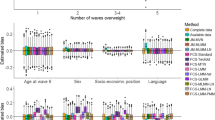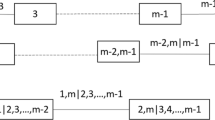Abstract
Multivariate binary responses from the same subject are usually correlated. For example, malnutrition of children are usually measured using ‘stunting’ (low height-for-age) and ‘wasting’ (low weight-for-age) calculated from their height, weight and age, and hence the status of being stunted may depend on the status of being wasted and vice-versa. For analyzing such malnutrition data, one needs special statistical models allowing for dependence between the responses to avoid misleading inference. The problem of dependence in multivariate binary responses is generally addressed by using marginal models with generalized estimating equation. However, using the marginal models alone, it is difficult to specify the measures of dependence between the responses precisely. Islam et al. (J Appl Stat 40(5):1064–1075, 2013) proposed a joint modeling approach for bivariate binary responses using both the conditional and marginal models where the dependence between the responses can be measured and tested using a link function of the models. However, the author didn’t examine the properties of the regression coefficient except for the dependence parameter. This paper has given further insight into the joint model and investigated the properties of regression coefficients using an extensive simulation study. The simulation results showed that the maximum likelihood estimators (MLEs) of the regression coefficients of the joint model showed well performance in terms of bias, mean squared error and coverage probability particularly when sample size large. Generally speaking, the MLEs of the parameters associated with joint models possessed the same asymptotic properties as the MLEs of those associated with standard generalized linear models, except for the interpretations. Further the paper provided an application of joint model for analyzing malnutrition data from Bangladesh demographic and health survey 2011. The results revealed that the estimates of the both marginal and condition regression coefficients of the joint model have meaningful interpretation and explanation, which will in turn help the policy makers for designing appropriate policies for improving nutrition status.
Similar content being viewed by others
References
Rahman, M.S., Howlader, T., Masud, M.S., Rahman, M.L.: Association of low-birth weight with malnutrition in children under five years in bangladesh: do mother’s education, socio-economic status, and birth interval matter? PLoS One 11(6), e0157814 (2016)
Rahman, A., Chowdhury, S.: Determinants of chronic malnutrition among preschool children in Bangladesh. J. Biosoc. Sci. 39, 161–173 (2007)
Mozumder, A.B.M.K.A., Kane, T., Levin, A., Ahmed, S.: The effect of birth interval on malnutrition in Bangladeshi infants and young children. J. Biosoc. Sci. 32, 289–300 (2000)
Cox, D.: The analysis of multivariate binary data. J. R. Stat. Soc. Ser. C 21, 113–120 (1972)
Leisch, F., Weingessel, A., Hornik, K.: On the generation of correlated artificial binary data. Working Paper Series, SFB Adaptive Information Systems and Modelling in Economics and Management Science, Vienna University of Economics (1988)
Lee, S., Jun, C.: Discriminant analysis of binary data following multivariate bernoulli distribution. Expert Syst. Appl. 38, 7795–7802 (2011)
Marshall, A.W., Olkin, I.: A family of bivariate distributions generated by the bivariate Bernoulli distribution. J. Am. Stat. Assoc. 80(390), 332–338 (1985)
Liang, K., Zeger, S.L.: Longitudinal data analysis using generalized linear models. Biometrika 73, 13–22 (1986)
Lipsitz, S.R., Laird, N., Harrington, D.: Generalized estimating equations for correlated binary data: using the odds ratio as a measure of association. Biometrika 78, 153–160 (1991)
Azzalini, A.: Logistic regression for autocorrelated data with application to repeated measures. Biometrika 81, 767–775 (1994)
Cessie, S.L., van Houwelingen, J.: Logistic regression for correlated binary data. J. R. Stat. Soc. C 43(1), 95–108 (1994)
Bergsma, W., Rudas, T.: Marginal models for categorical data. Ann. Stat. 30, 140–159 (2002)
Molenberghs, G., Lesaffre, E.: Marginal modelling of correlated ordinal data using a multivariate plackett distribution. J. Am. Stat. Assoc. 89, 633–644 (1994)
Wakefield, J.: Ecological inferences for 2 2 tables. J. R. Stat. Soc. A 167, 385–445 (2004)
Muenz, L., Rubinstein, L.: Markov models for covariate dependence of binary sequence. Biometrics 41, 91101 (1985)
Islam, M.A., Chowdhury, R.I.: A higher order markov model for analyzing covariate dependence. Appl. Math. Model. 2006(30), 477–488 (2006)
Islam, M.A., Alzaid, A.A., Chowdhury, R.I., Sultan, K.S.: A generalized bivariate Bernoulli model with covariate dependence. J. Appl. Stat. 40(5), 1064–1075 (2013)
NIPORT, Associates M, International I.: Bangladesh demographic and health survey. Technical report, National Institute of Population Research and Training (NIPORT), Dhaka, Bangladesh (2011)
McCullagh, P., Nelder, J.: Generalized Linear Models, 2nd edn. Chapman and Hall, London (1989)
General Economics Division.: Millennium Development Goals: Bangladesh Progress Report 2015. Technical report, Planning Commission, Government of the Peoples Republic of Bangladesh
Save the Children.: Malnutrition in Bangladesh: harnessing social protection for the most vulnerable. Technical report, Save the Children, London, UK (2015)
Haque, S.M.R., Tisha, S., Huq, N.: Public Health Research. Poor Birth Size a Badge of Low Birth Weight Accompanying Less Antenatal Care in Bangladesh with Substantial Divisional Variation: Evidence from BDHS-2011. Public Health Res. 30, 184–191 (2015)
Acknowledgements
The authors acknowledge the National Institute of Population Research and Training (NIPORT), ICF International (USA), and Mitra and Associates who work for this survey under the world-wide Demographic and Health Survey (DHS) program for providing data.
Funding
This study received no specific funding. However, the author M. Ataharul Islam has received research grant (CP 3293) from the Higher Education Quality Enhancement Project (HEQEP) funder by the World Bank.
Author information
Authors and Affiliations
Corresponding author
Ethics declarations
Author’s contribution
MJB analyzed the data. MSR and MJB drafted the paper. MAI provided constructive comments to improve the paper. All authors approved the final version of the paper.
Availability of data
The dataset used in this research are from a secondary source at Demographic and Health Survey (DHS) program and can be downloaded upon request from http://dhsprogram.com/what-we-do/survey/survey-display-349.cfm.
Conflict of interest
The author Mohammad Junayed Bhuyan has received travel grant from International Statistical Institute (ISI) for presenting this work at the Public Health Workshop organized by ISI and University of Kolkata. The author M. Ataharul Islam has received research grant from HEQEP and M. Shafiqur Rahman has declared no conflicts of interest.
Ethical approval
The data used in this research are from secondary source and the respective authority (NIPORT, ICF International, and Mitra and Associates) who collected data from individual has ethical approval from the national ethical review committee.
Informed consent
Informed consent was obtained by the respective authority who collected data from all individual participants included in the study.
Rights and permissions
About this article
Cite this article
Bhuyan, M.J., Islam, M.A. & Rahman, M.S. A bivariate Bernoulli model for analyzing malnutrition data. Health Serv Outcomes Res Method 18, 109–127 (2018). https://doi.org/10.1007/s10742-018-0180-9
Received:
Revised:
Accepted:
Published:
Issue Date:
DOI: https://doi.org/10.1007/s10742-018-0180-9




